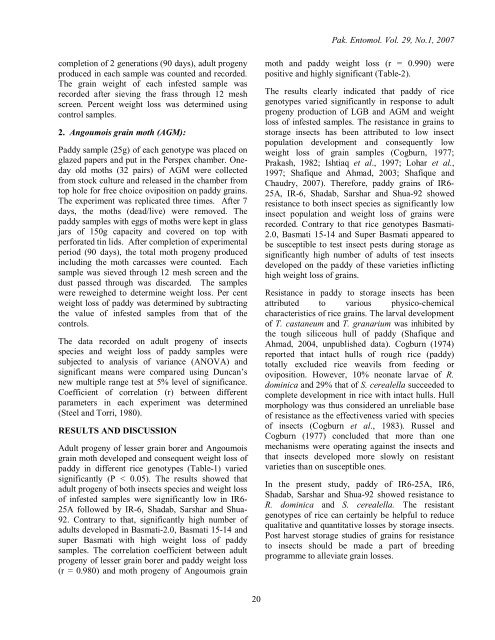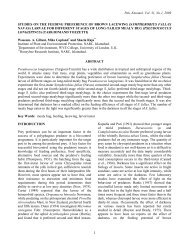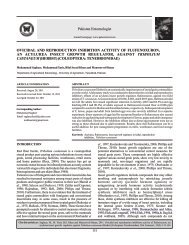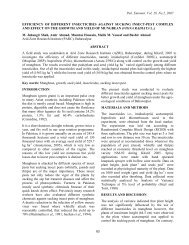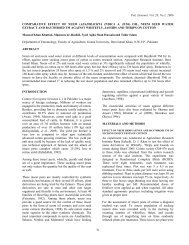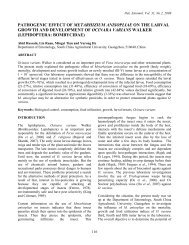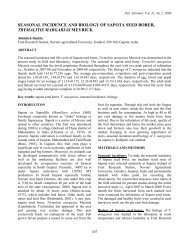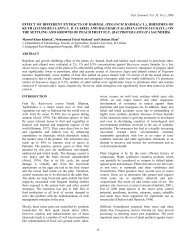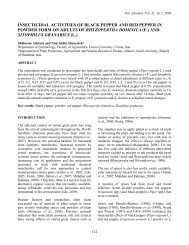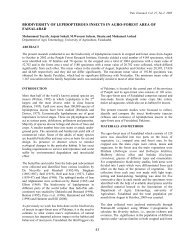screening of rice genotypes for resistance to storage insects
screening of rice genotypes for resistance to storage insects
screening of rice genotypes for resistance to storage insects
Create successful ePaper yourself
Turn your PDF publications into a flip-book with our unique Google optimized e-Paper software.
Pak. En<strong>to</strong>mol. Vol. 29, No.1, 2007<br />
completion <strong>of</strong> 2 generations (90 days), adult progeny<br />
produced in each sample was counted and recorded.<br />
The grain weight <strong>of</strong> each infested sample was<br />
recorded after sieving the frass through 12 mesh<br />
screen. Percent weight loss was determined using<br />
control samples.<br />
2. Angoumois grain moth (AGM):<br />
Paddy sample (25g) <strong>of</strong> each genotype was placed on<br />
glazed papers and put in the Perspex chamber. Oneday<br />
old moths (32 pairs) <strong>of</strong> AGM were collected<br />
from s<strong>to</strong>ck culture and released in the chamber from<br />
<strong>to</strong>p hole <strong>for</strong> free choice oviposition on paddy grains.<br />
The experiment was replicated three times. After 7<br />
days, the moths (dead/live) were removed. The<br />
paddy samples with eggs <strong>of</strong> moths were kept in glass<br />
jars <strong>of</strong> 150g capacity and covered on <strong>to</strong>p with<br />
per<strong>for</strong>ated tin lids. After completion <strong>of</strong> experimental<br />
period (90 days), the <strong>to</strong>tal moth progeny produced<br />
including the moth carcasses were counted. Each<br />
sample was sieved through 12 mesh screen and the<br />
dust passed through was discarded. The samples<br />
were reweighed <strong>to</strong> determine weight loss. Per cent<br />
weight loss <strong>of</strong> paddy was determined by subtracting<br />
the value <strong>of</strong> infested samples from that <strong>of</strong> the<br />
controls.<br />
The data recorded on adult progeny <strong>of</strong> <strong>insects</strong><br />
species and weight loss <strong>of</strong> paddy samples were<br />
subjected <strong>to</strong> analysis <strong>of</strong> variance (ANOVA) and<br />
significant means were compared using Duncan’s<br />
new multiple range test at 5% level <strong>of</strong> significance.<br />
Coefficient <strong>of</strong> correlation (r) between different<br />
parameters in each experiment was determined<br />
(Steel and Torri, 1980).<br />
RESULTS AND DISCUSSION<br />
Adult progeny <strong>of</strong> lesser grain borer and Angoumois<br />
grain moth developed and consequent weight loss <strong>of</strong><br />
paddy in different <strong>rice</strong> <strong>genotypes</strong> (Table-1) varied<br />
significantly (P < 0.05). The results showed that<br />
adult progeny <strong>of</strong> both <strong>insects</strong> species and weight loss<br />
<strong>of</strong> infested samples were significantly low in IR6-<br />
25A followed by IR-6, Shadab, Sarshar and Shua-<br />
92. Contrary <strong>to</strong> that, significantly high number <strong>of</strong><br />
adults developed in Basmati-2.0, Basmati 15-14 and<br />
super Basmati with high weight loss <strong>of</strong> paddy<br />
samples. The correlation coefficient between adult<br />
progeny <strong>of</strong> lesser grain borer and paddy weight loss<br />
(r = 0.980) and moth progeny <strong>of</strong> Angoumois grain<br />
moth and paddy weight loss (r = 0.990) were<br />
positive and highly significant (Table-2).<br />
The results clearly indicated that paddy <strong>of</strong> <strong>rice</strong><br />
<strong>genotypes</strong> varied significantly in response <strong>to</strong> adult<br />
progeny production <strong>of</strong> LGB and AGM and weight<br />
loss <strong>of</strong> infested samples. The <strong>resistance</strong> in grains <strong>to</strong><br />
s<strong>to</strong>rage <strong>insects</strong> has been attributed <strong>to</strong> low insect<br />
population development and consequently low<br />
weight loss <strong>of</strong> grain samples (Cogburn, 1977;<br />
Prakash, 1982; Ishtiaq et al., 1997; Lohar et al.,<br />
1997; Shafique and Ahmad, 2003; Shafique and<br />
Chaudry, 2007). There<strong>for</strong>e, paddy grains <strong>of</strong> IR6-<br />
25A, IR-6, Shadab, Sarshar and Shua-92 showed<br />
<strong>resistance</strong> <strong>to</strong> both insect species as significantly low<br />
insect population and weight loss <strong>of</strong> grains were<br />
recorded. Contrary <strong>to</strong> that <strong>rice</strong> <strong>genotypes</strong> Basmati-<br />
2.0, Basmati 15-14 and Super Basmati appeared <strong>to</strong><br />
be susceptible <strong>to</strong> test insect pests during s<strong>to</strong>rage as<br />
significantly high number <strong>of</strong> adults <strong>of</strong> test <strong>insects</strong><br />
developed on the paddy <strong>of</strong> these varieties inflicting<br />
high weight loss <strong>of</strong> grains.<br />
Resistance in paddy <strong>to</strong> s<strong>to</strong>rage <strong>insects</strong> has been<br />
attributed <strong>to</strong> various physico-chemical<br />
characteristics <strong>of</strong> <strong>rice</strong> grains. The larval development<br />
<strong>of</strong> T. castaneum and T. granarium was inhibited by<br />
the <strong>to</strong>ugh siliceous hull <strong>of</strong> paddy (Shafique and<br />
Ahmad, 2004, unpublished data). Cogburn (1974)<br />
reported that intact hulls <strong>of</strong> rough <strong>rice</strong> (paddy)<br />
<strong>to</strong>tally excluded <strong>rice</strong> weavils from feeding or<br />
oviposition. However, 10% neonate larvae <strong>of</strong> R.<br />
dominica and 29% that <strong>of</strong> S. cerealella succeeded <strong>to</strong><br />
complete development in <strong>rice</strong> with intact hulls. Hull<br />
morphology was thus considered an unreliable base<br />
<strong>of</strong> <strong>resistance</strong> as the effectiveness varied with species<br />
<strong>of</strong> <strong>insects</strong> (Cogburn et al., 1983). Russel and<br />
Cogburn (1977) concluded that more than one<br />
mechanisms were operating against the <strong>insects</strong> and<br />
that <strong>insects</strong> developed more slowly on resistant<br />
varieties than on susceptible ones.<br />
In the present study, paddy <strong>of</strong> IR6-25A, IR6,<br />
Shadab, Sarshar and Shua-92 showed <strong>resistance</strong> <strong>to</strong><br />
R. dominica and S. cerealella. The resistant<br />
<strong>genotypes</strong> <strong>of</strong> <strong>rice</strong> can certainly be helpful <strong>to</strong> reduce<br />
qualitative and quantitative losses by s<strong>to</strong>rage <strong>insects</strong>.<br />
Post harvest s<strong>to</strong>rage studies <strong>of</strong> grains <strong>for</strong> <strong>resistance</strong><br />
<strong>to</strong> <strong>insects</strong> should be made a part <strong>of</strong> breeding<br />
programme <strong>to</strong> alleviate grain losses.<br />
20


